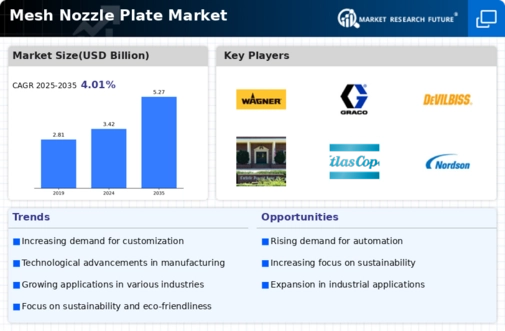Environmental Regulations
The Global Mesh Nozzle Plate Market Industry is also shaped by stringent environmental regulations aimed at promoting sustainable practices. Governments worldwide are implementing policies that encourage the use of eco-friendly materials and technologies in manufacturing processes. This regulatory landscape compels manufacturers to innovate and adopt mesh nozzle plates that meet these standards, thereby reducing environmental impact. As industries strive to comply with these regulations, the demand for high-quality, environmentally friendly nozzle plates is expected to rise. This shift may contribute to the market's growth, with projections indicating a market size of 5.27 USD Billion by 2035.
Market Growth Projections
The Global Mesh Nozzle Plate Market Industry is poised for substantial growth, with projections indicating a market size of 3.42 USD Billion in 2024 and an anticipated increase to 5.27 USD Billion by 2035. This growth trajectory suggests a robust demand for mesh nozzle plates across various sectors, driven by technological advancements and increasing applications. The market is expected to experience a CAGR of 4.02% from 2025 to 2035, reflecting the ongoing evolution of industries that rely on efficient fluid management solutions. These projections underscore the potential for innovation and expansion within the market.
Technological Advancements
The Global Mesh Nozzle Plate Market Industry is experiencing a surge in technological advancements that enhance the efficiency and performance of nozzle plates. Innovations in materials and manufacturing processes, such as 3D printing and advanced coatings, are driving the development of more durable and efficient products. These advancements not only improve the operational lifespan of nozzle plates but also reduce maintenance costs. As a result, manufacturers are increasingly adopting these technologies to meet the growing demand for high-performance nozzle plates, which is projected to contribute to the market's growth, with a valuation expected to reach 3.42 USD Billion in 2024.
Rising Demand in Agriculture
The Global Mesh Nozzle Plate Market Industry is significantly influenced by the rising demand for efficient irrigation systems in agriculture. As global food production needs escalate, farmers are seeking advanced irrigation technologies that optimize water usage and enhance crop yields. Mesh nozzle plates play a crucial role in these systems by ensuring uniform water distribution and minimizing waste. This trend is likely to drive market growth, as the agricultural sector increasingly adopts innovative solutions. The market is projected to grow at a CAGR of 4.02% from 2025 to 2035, reflecting the increasing reliance on efficient irrigation technologies.
Growth in Industrial Applications
The Global Mesh Nozzle Plate Market Industry is witnessing growth due to the expanding applications in various industrial sectors, including automotive, aerospace, and chemical processing. These industries require precise fluid control and distribution, which mesh nozzle plates can provide. The increasing complexity of manufacturing processes necessitates the use of advanced nozzle technologies to enhance efficiency and product quality. As industries continue to evolve and demand higher performance standards, the adoption of mesh nozzle plates is likely to increase, further propelling market growth. This trend aligns with the overall market trajectory, which is expected to reach 3.42 USD Billion in 2024.
Emerging Markets and Global Expansion
The Global Mesh Nozzle Plate Market Industry is benefiting from the expansion into emerging markets, where industrialization and urbanization are on the rise. Countries in Asia-Pacific and Latin America are experiencing increased investments in infrastructure and agriculture, driving the demand for advanced nozzle technologies. As these regions develop, the need for efficient fluid management systems becomes critical, thereby boosting the adoption of mesh nozzle plates. This trend is likely to enhance market growth, with projections indicating a robust CAGR of 4.02% from 2025 to 2035, as these markets continue to mature and demand sophisticated solutions.












